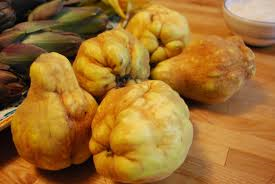To All,
One of the satisfactions of fruit exploring is discovering bizarre-looking fruit. The quince easily qualifies for this category with its irregular, bulbous top. It looks like a fruit concocted in Frankenstein's laboratory.There is a lot of variety in the shape of quinces, and you will find it entertaining to paw through the quince bin and observe the irregularities that swarm before you.
It was a surprise when I found quinces being sold by Market Basket for $2.39. I had heard of quinces but never seen one and was unaware that they could be purchased. My quince was green, but most of the quinces that are pictured on the Internet are yellow. My quince was intermediate in size between an apple and a grapefruit. The quince is in the same family as apples, pears, peaches, and cherries.
Recall that the Asian pear (May 16) sported in a shock-absorbing wrapper since it is noted for being a fragile fruit. My quince came in a somewhat similar plastic holder, but it was such cheap plastic that I doubt if it provided much protection. It made my quince look like it was squatting in its nest.
It is thought that the quince was cultivated even earlier than the apple, and the quince was a familiar fruit in the ancient world. Recall that in the Judgment of Paris, Paris was asked to choose which of Aphrodite, Hera, and Pallas Athena should receive a golden apple inscribed "For the Fairest." He awarded the golden apple to Aphrodite, and the golden apple is interpreted as being a quince.
According to Wikipedia, Plutarch says that a newly married bride would nibble a quince before her wedding night to sweeten her kiss and not revolt the bridegroom on first encounter.
I went to the Internet to find out how to eat a quince, and was surprised to find no video on this. The answer emerged when I found on http://www.simplyrecipes.com/quince/ that, "Quince cannot be eaten raw, they are too tart." This site gives a recipe for making quince jelly, which is apparently the most common use of quince. This recipe's only ingredients are quince, water, and sugar--a lot of sugar. No other ingredient is needed since quince is naturally high in pectin. This means that it can be used to make glue. Here are pictures of the red jelly that quince produces.
Where does the red come from since the peel is green or yellow and the inside white? Perhaps a clue is that the flower is also red. Here are pictures to give you a sense both of individual flowers and also of the quince shrub in full flower.
Now I know why the bride only nibbled the quince. I also know why I have never eaten a quince or seen it for sale. Maybe there is a lesson here for blind buying of fruit.
Recall that Market Basket was where I bought a sour orange, so Market Basket seems to be the market of choice for sour fruits that are good ingredients for homemade jelly. I had no idea that sour fruits were in such demand for home-made jellies and marmalades. On the one hand, maybe I should attend a local convention and learn about this specialized aspect of the world of fruit. On the other hand, maybe I would find that in this arena, as in others, there is discord and back-biting and that the jelly people and the marmalade people can't stand each other.
Cognizant of the fact that the Internet harbors countless errors, I resolved to give my quince a try. I cut off a slice and bit into it. It was as advertised; I spit it out.
Verdict: This fruit has visual appeal only. (Unfortunately, my test was not definitive since textbook quinces are a bright golden-yellow when ripe and mine was green. Therefore, my taste test labored under the double whammy of a fruit that was not only inedible but possibly also unripe. Therefore, I cannot claim that I gave quince a fair test.)
Such are the tribulations of fruit exploring.















